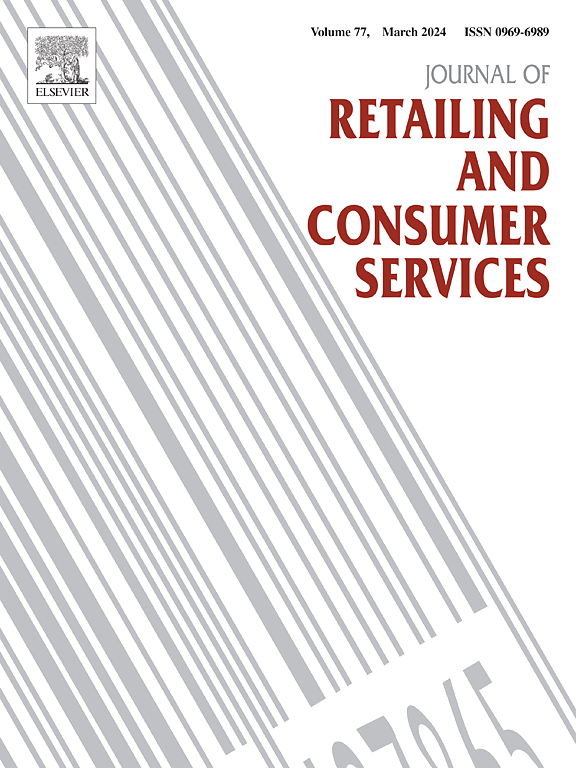风险对购买信心及后续购买意愿的影响:产品容器触觉的调节作用
IF 11
1区 管理学
Q1 BUSINESS
Journal of Retailing and Consumer Services
Pub Date : 2025-06-11
DOI:10.1016/j.jretconser.2025.104354
引用次数: 0
摘要
本研究考察了容器触觉在感知风险对消费者购买信心和随后购买意愿影响中的调节作用。虽然与产品评价无关,但容器的触觉线索会影响消费者对其所含产品的广泛反应。到目前为止,他们对信心的作用从未被研究过,但信心是消费者决策的中心变量,因为大多数购买情况都涉及某种程度的感知风险。迄今为止,关于触摸的文献主要展示了触摸产品比不触摸产品对信心的积极影响。本研究基于具身认知理论,探讨了容器产生的触觉对购买信心的影响。具体而言,本研究探讨了硬度和重量的触觉如何调节感知风险对购买信心的影响,并最终影响购买意愿。在三个实验中,两个参与者处于实际触摸状态(研究1和2),另一个参与者处于无触摸状态(即在线;在研究3a和3b中,受访者被要求想象自己在超市里品尝一种饮料。感知风险水平(低或高)被操纵,并考虑了两种类型的风险:物理风险(实验1,3a, &;3b)和社会风险(实验2)。触觉是通过触摸(实际的或想象的)塑料或玻璃容器来收集的。结果表明,感知风险(无论是物理风险还是社会风险)对消费者购买信心的负面影响在中等到高的感知硬度或重量水平上被消除。然而,只有当消费者与容器进行直接的触觉互动时,才会观察到这些效果。本研究对容器的触觉输入在购买情境中的影响做出了新的贡献,强调了某些触觉感受在体验时如何减少风险对消费者购买信心的负面影响。鉴于许多购买决定产生的风险感知,这些发现也提供了新的见解包装创新的持续发展。本文章由计算机程序翻译,如有差异,请以英文原文为准。
The effect of risk on purchase confidence and subsequent purchase intention: The moderating role of product container haptic sensations
This research examines the role of container haptic sensations as a moderator of the effect of perceived risk on consumer purchase confidence and subsequent purchase intention. Although not relevant to product evaluation, the haptic cues of a container influence a wide range of consumer responses to the product it contains. Until now, their role on confidence has never been examined, yet confidence is a central variable in consumer decision making, as most purchase situations can involve some degree of perceived risk. To date, the literature on touch has mainly demonstrated the positive impact that touching a product, compared to not touching it, has on confidence. Based on embodied cognition theory, the present research investigated the role of haptic sensations generated by containers on confidence in the purchase. Specifically, this research examines how haptic sensations of hardness and heaviness moderate the impact of perceived risk on purchase confidence and, ultimately, purchase intention. In three experiments, two in which participants were in actual touch conditions (studies 1 and 2) and one in which they were in no-touch conditions (i.e., online; studies 3a and 3b), respondents were asked to imagine themselves at a supermarket in-store tasting for a beverage. Levels of perceived risk (low or high) were manipulated, and two types of risk were considered: a physical risk (experiments 1, 3a, & 3b) and a social risk (experiment 2). Haptic sensations were collected by touching (actual or imagined) a plastic or glass container. The results indicate that the negative effect of perceived risk—whether physical or social—on consumer purchase confidence is eliminated at moderate to high levels of perceived hardness or heaviness. However, these effects are observed only when consumers engage in direct tactile interaction with the container. This study makes a new contribution to the influence of containers' tactile inputs in purchasing contexts, highlighting how certain haptic sensations, when experienced, can reduce the negative influence of risk on consumers’ confidence in their purchases. Given that many purchase decisions generate a perception of risk, these findings also offer new insights into the ongoing development of packaging innovations.
求助全文
通过发布文献求助,成功后即可免费获取论文全文。
去求助
来源期刊
CiteScore
20.40
自引率
14.40%
发文量
340
审稿时长
20 days
期刊介绍:
The Journal of Retailing and Consumer Services is a prominent publication that serves as a platform for international and interdisciplinary research and discussions in the constantly evolving fields of retailing and services studies. With a specific emphasis on consumer behavior and policy and managerial decisions, the journal aims to foster contributions from academics encompassing diverse disciplines. The primary areas covered by the journal are:
Retailing and the sale of goods
The provision of consumer services, including transportation, tourism, and leisure.

 求助内容:
求助内容: 应助结果提醒方式:
应助结果提醒方式:


